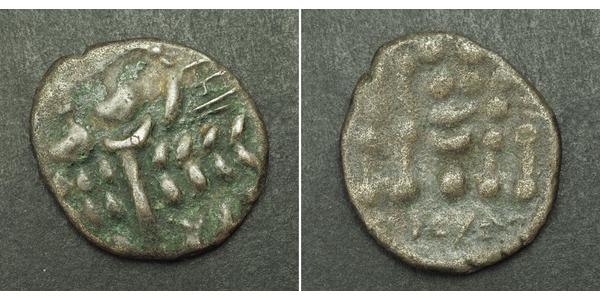(售价 $27.0)
Celtic Brittania, Durotriges., Craborne Chase. (58 BC - AD 43) AR Stater Coin. VF/F+
Region: Craborne Chase Denomination: AR Stater Mint Period: 58 BC - AD 43 Reference: BMC 2525-46, SCBC 366. Culture: Durotriges (Celtic Tribes in Britain) Condition: Greenish deposits (vendigris) in obverse, otherwise VF/F+ Material: Billon Silver (low grade) Diameter: 20mm Weight: 3.83gm
Obverse: Wreath, cloak and crescents.
Reverse: Disjointed horse left, with rectangular head, body of crescents, four vertical legs, three roughly horizontal lines for tail; pellet below; twelve pellets above.
Cranborne Chase (grid reference ST970180) is a chalk plateau in central southern England, straddling the counties Dorset, Hampshire and Wiltshire. The plateau is part of the English Chalk Formation and is adjacent to Salisbury Plain and the West Wiltshire Downs in the north, and the Dorset Downs to the south west. The scarp slope of the hills faces the Blackmore Vale to the west, and to some extent the Vale of Wardour to the north. The chalk gently slopes south and dips under clays and gravels. An area of 379 square miles (981 square kilometres) of Cranborne Chase and the West Wiltshire Downs has been designated an Area of Outstanding Natural Beauty (AONB), the sixth largest AONB in the country. The highest point is Win Green, in Wiltshire, at 910 ft (277 m).
Authenticity unconditionally guaraneed.
The Durotriges were one of the Celtic tribes living in Britain prior to the Roman invasion. The tribe lived in modern Dorset, south Wiltshire, south Somerset and Devon east of the River Axe and the discovery of an Iron Age hoard in 2009 at Shalfleet, Isle of Wight gives evidence that they lived in the western half of the island. After the Roman conquest, their main civitates, or settlement-centred administrative units, were Durnovaria (modern Dorchester, "the probable original capital") and Lindinis (modern Ilchester, "whose former, unknown status was thereby enhanced"). Their territory was bordered to the west by the Dumnonii; and to the east by the Belgae.
Durotriges were more a tribal confederation than a tribe. They were one of the groups that issued coinage before the Roman conquest, part of the cultural "periphery", as Barry Cunliffe characterised them, round the "core group" of Britons in the south. These coins were rather simple and had no inscriptions, and thus no names of coin-issuers can be known, let alone evidence about monarchs or rulers. Nevertheless, the Durotriges presented a settled society, based in the farming of lands[3] surrounded and controlled by strong hill forts that were still in use in 43 AD. Maiden Castle is a preserved example of one of these hill forts.
The area of the Durotriges is identified in part by coin finds: few Durotrigan coins are found in the "core" area, where they were apparently unacceptable and were reminted. To their north and east were the Belgae, beyond the Avon and its tributary Wylye: "the ancient division is today reflected in the county division between Wiltshire and Somerset." Their main outlet for the trade across the Channel, strong in the first half of the 1st century BC, when the potter's wheel was introduced, then drying up in the decades before the advent of the Romans, was at Hengistbury Head. Numismatic evidence shows progressive debasing of the coinage, suggesting economic retrenchment accompanying the increased cultural isolation. Analysis of the body of Durotrigan ceramics suggests to Cunliffe that the production was increasingly centralised, at Poole Harbour (Cunliffe 2005:183).
Burial of Durotriges was by inhumation, with a last ritual meal provided even under exiguous circumstances, as in the eight burials at Maiden Castle, carried out immediately after the Roman attack. Most Durotrigian burials are laid down in crouched positions within shallow, oval graves. One such inhumation of a young Durotrigian woman was found at Langton Herring in Dorset in 2010. The burial, which was laid down with a decorated mirror, had a radiocarbon date of between AD 25 – 53.
Not surprisingly, the Durotriges resisted Roman invasion in AD 43, and the historian Suetonius records some fights between the tribe and the second legion Augusta, then commanded by Vespasian. By 70 AD, the tribe was already Romanised and securely included in the Roman province of Britannia. In the tribe’s area, the Romans explored some quarries and supported a local pottery industry.
The Durotriges, and their relationship with the Roman Empire, form the basis for an ongoing archaeological research project directed by Paul Cheetham, Ellen Hambleton and Miles Russell of Bournemouth University. The Durotriges Project has, since 2009, been reconsidering the Iron Age to Roman transition through a detailed programme of field survey, geophysical investigation and targeted excavation. To date the programme of work has concentrated upon an enclosed late Iron Age banjo enclosure containing round houses, work surfaces and storage pits, a Late Iron Age cemetery and two Roman villas.
Only 1$ shipping for each additional coin purchased!
3 Gulden 荷蘭共和國 (1581 - 1795) 銀
本组有 22 钱币 / 20 售价
⇑
5 Lira Italian city-states 銀 卡洛·費利切
本组有 6 钱币 / 5 售价
⇑







-300-150-TCkKbzbinggAAAFNnIptvxI3.jpg)








